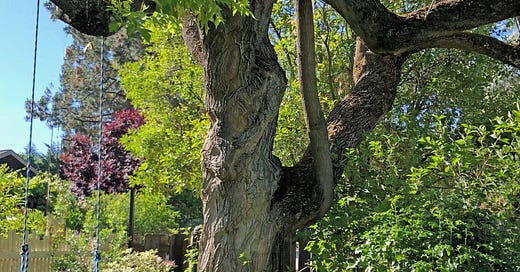This tree is located at the corner of our property. It’s a good 3 feet across at its base, and it has an absolutely awesome wingspan that soars out over our yard (and the neighbor’s) with ginormous limbs. It throws a lot of shade.
It’s also dying.
It’s a gnarly old beast, as you can see by the twisted trunk and the suckers that are shooting up everywhere. Our tree guy, Mack, says that this ash tree is probably good for “another five to six years,” which is an event horizon that seems ominously speculative.
Trouble is, I love this tree. It’s an old guy sitting on a park bench in the sun feeding pigeons and telling stories to anyone who will listen. It’s a bodhisattva, a sensei, a silent monk. Stellar jays crawk from its branches; raccoons poop appreciatively in the comfortable crotches of the big limbs; it’s a Grand Central Station for squirrels. It has known so much. And it’s dying.
I love it for its stubborn desire to keep going even as old age begins to soften its insides, eat out its heart, invite disease. Each pruned branch reveals a dark and emaciated core. The leaves are prolific in a panicked sort of way, as if they’re in a giant hurry to produce chlorophyll that—if they only knew—will only temporarily postpone the inevitable. Exhausted, the leaves begin falling in mid-summer.
Which brings me to an existential dilemma. Or more accurately, an existential Russian roulette. How long do I let this big tree linger before it becomes a danger? If it falls in any direction, the consequences would be dire. Toward my neighbor’s property, it would take out their new fence and their flowering plum—a truly decent tree in comparison to our unruly behemoth. Falling the other way would deposit much of its bulk on our roof and the guest bedroom, which theoretically wouldn’t endanger anybody except guests, who might be considered expendable anyway, depending on how long they’ve been visiting. And cue the insurance snakes.
I weigh the cost of removal (around $4,000) and the resulting safety against the pleasure of its presence in our everyday lives. And I always come to the same conclusion: we won’t be taking it down today, and probably not tomorrow. But sometime.
Mack the tree guy was wrong, by the way. It’s not an ash. It’s a box elder, Acer negundo, a member of the maple family. My venerable gardening reference, Sunset’s “Western Garden Book,” says A. negundo is “a weed tree of many faults—it seeds readily, hosts box elder bugs, suckers badly and is subject to breakage.” What they fail to include is that this big mass of twisted limbs is our weed tree. It’s accepted and cherished.
Some ten feet away from the box elder is a comely vine maple, and nearby is a fetching mountain ash. Foot-high oak trees from acorn-burying squirrels ring its wide base. Replacements are standing by. We’ve even engaged in heretical thoughts of planting a substitute flowering plum when the big tree finally gives way. But that’s gardening—trial, error, failure, success, reward, progeny, phylogeny, and inevitably, dead-ology. There are sorrows and joys and—through it all—things keep growing.




